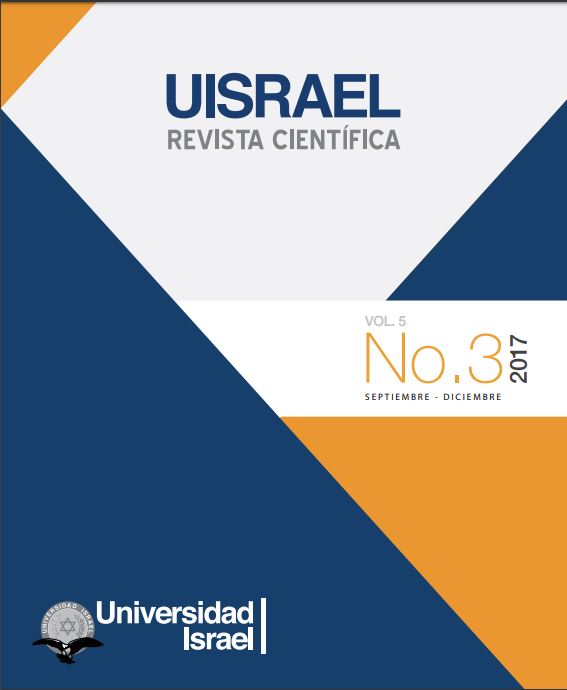Tendencias tecnológicas para módulos autónomos en el laboratorio de Física
DOI:
https://doi.org/10.35290/rcui.v4n3.2017.80Palabras clave:
Tendencias tecnológicas, módulos autónomos, laboratorio de físicaResumen
Las actividades experimentales son parte fundamental del proceso educativo de enseñanza-aprendizaje de la física; sin embargo, las clases de laboratorio no son aprovechadas eficientemente, debido a que en algunos institutos de educación de Ecuador no existen lugares propiados o se limitan a realizar prácticas con equipos e instrumentos obsoletos, y encima cada medición la realiza un solo operador. Todo esto trae como consecuencia que la toma de datos se efectúe con un nivel muy alto de errores, tanto de tipo accidental como sistemáticos. Para tratar de solventar esta situación se están desarrollando módulos autónomos para las clases de laboratorio de Física apoyados en las tendencias tecnológicas actuales.
Con el objetivo de describir cómo pueden utilizarse las tendencias tecnológicas en los módulos autónomos para el desarrollo de actividades de laboratorio en Física, se realizó la presente investigación documental descriptiva, desde el marco referencial interpretativo de la hermenéutica y sustentada teóricamente en las tendencias tecnológicas actuales, así como en la manera en que estas pueden ser aprovechadas en la enseñanza práctica de la Física a nivel universitario. Con este propósito se realizó la descripción de tecnologías emergentes tales como la inteligencia artificial, la realidad aumentada, el internet de las cosas, la experiencia inmersiva, blockchain y la conectividad 5G, y se determinaron sus implicaciones y posibles usos didácticos para los módulos autónomos en el laboratorio de Física. Se destaca como consideración final que la posibilidad de conectividad ultrarrápida y la toma de decisiones de forma automatizada favorecen positivamente el proceso de enseñanzaaprendizaje de la Física.
Descargas
Referencias
Palacios, J.; Palacio, H. y González, R. (2018). Educación versus tecnología y su convergencia hacia la IA. Revista Vínculos: Ciencia, Tecnología y Sociedad, 15(2), 186-194.
Leckie, A. (2015). Justicia auxiliar. Madrid: Penguin Random House.
Ierache, J., Igarza, S., Mangiarua, N., Becerra, M., Bevacqua, S., Verdicchio, N., Ortiz, F., Sanz, D., Duarte, N. y Sena, M. (2014). Herramienta de Realidad Aumentada para facilitar la enseñanza en contextos educativos mediante el uso de las TICs. Revista Latinoamericana de Ingeniería de Software, 2(6), 365-368.
Novillo, J., Hernández, D., Mazón, B., Molina, J. y Cárdenas, O. (2018). Arduino y el Internet de las cosas. Área de Innovación y Desarrollo, S.L., España.
Freina, L. y Ott, M. (2015). A literature review on immersive virtual reality in education: State of the art and perspectives. En: eLSE Conference, Bucharest.
Adell, J. y Bellver, C. (2018). Blockchain en la educación superior: una visión crítica. En: Bartolomé, A. y Moral-Ferrer, J. M. (Eds.): Blockchain en Educación. Barcelona: LMI, pp. 193-211. España: Colección Transmedia XXI.
Cuartero, A. (2017). Blockchain y su aplicabilidad a una industria bajo regulación (trabajo final de maestría). Universitat Oberta de Catalunya, España.
Husenovic, K., Bedi, I. y Maddens. (2018). Sentando las bases para la 5G: Oportunidades y desafíos. Informe ITU, Ginebra, Suiza.
Gil, S. (2014). Experimentos de física, de bajo costo usando TIC´s. Buenos Aires, Argentina: Alfaomega.
Montero, G., García, A., Ríos, V. y Román, A. (2017). Estudio de la caída libre utilizando diferentes técnicas experimentales. Lat. Am. J. Phys. Educ. 12(1), 1-8.
Delgado, M.; Arrieta, X. y Riveros, V. (2014). Lineamientos teórico-metodológicos para el uso de las TIC en la formación de conceptos científicos en Física. REDHECS, 17, 20-43.
Álvarez-Gayou, J. (2009). Cómo hacer investigación cualitativa. Fundamentos y metodología. México: Paidós Mexicana, S. A.
Padilla, R., Cadenas, S., Enríquez, R., Córdoba, J. y Llorens, F. (2018). Estado de las Tecnologías de la Información y la Comunicación en las Universidades Ecuatorianas. Ecuador: REDCEDIA.
Sandoval, E. (2018): Aprendizaje e inteligencia artificial en la era digital: implicancias socio- pedagógicas ¿rea-les o futuras? Revista boletín REDIPE, 7(11), 155-171.
Smith, B. y Shum, H. (2018). Las repercusiones de la IA en la sociedad. En: Inteligencia artificial para el bien en el mundo. ITU News Magazine, 32-40. Ginebra, Suiza.
Tech Data Corporation (2019). Internet de las cosas desde abajo: dispositivos y controladores físicos. Recuperado de http://blog.techdata.com/ts/latam/internet-de-las-cosas-desde-abajo-dispositivos-y- controladores-f%C3%ADsicos.
Educación 3.0 (2019). Principales aplicaciones de la tecnología blockchain en Educación. Recuperado de https://
www.educaciontrespuntocero.com/noticias/aplicaciones-tecnologia-blockchain-en- educacion/89119.html.
Fernández, C. (2019). 5 formas en las que el 5G va a transformar la educación. Recuperado de https://www.bu- sinessinsider.es/5-formas-5g-va-transformar-educacion-370735.
Descargas
Publicado
Número
Sección
Licencia
Derechos de autor 2017 Revista Científica UISRAEL

Esta obra está bajo una licencia internacional Creative Commons Atribución 4.0.
Los autores que participen de los procesos de evaluación y publicación de sus ediciones conservan los derechos de autor y ceden a la revista el derecho a la primera publicación, tal como establecen las condiciones de reconocimiento en la licencia Creative Commons Reconocimiento 4.0 Internacional (CC BY), donde los autores autorizan el libre acceso a sus obras, permitiendo que los lectores copien, distribuyan y transmitan por diversos medios, garantizando una amplia difusión del conocimiento científico publicado.
- Toda derivación, a partir de esta obra, deberá citar la fuente y a la primera publicación en esta revista. Se permiten derechos comerciales no lucrativos sobre sus contenidos.
- Los autores pueden realizar otros acuerdos contractuales independientes y adicionales para la distribución no exclusiva de la versión del artículo publicado en esta revista, es decir, podrán incluirlo en un repositorio institucional o publicarlo en un libro, siempre que indiquen claramente que el trabajo se publicó por primera vez en esta revista.
- Se permite y recomienda a los autores compartir su trabajo en línea, con la finalidad de intercambios productivos para una mayor y más rápida citación del trabajo como lo establece los efectos del movimiento ‘Acceso Abierto’.
- No puede aplicar términos legales o medidas tecnológicas que restrinjan legalmente a otros de hacer cualquier cosa que permita la licencia: https://creativecommons.org/licenses/by/4.0/deed.es
- La Revista Científica es financiada completamente de los aportes realizados por nuestra entidad editora: Universidad Tecnológica Israel; por tal motivo, no establece cargos o cobros de ninguna índole a sus autores y colaboradores, así como tampoco genera pagos o remuneraciones de ningún tipo a ellos.
- Se asignará un Digital Object Identifier (DOI) a cada publicación.







